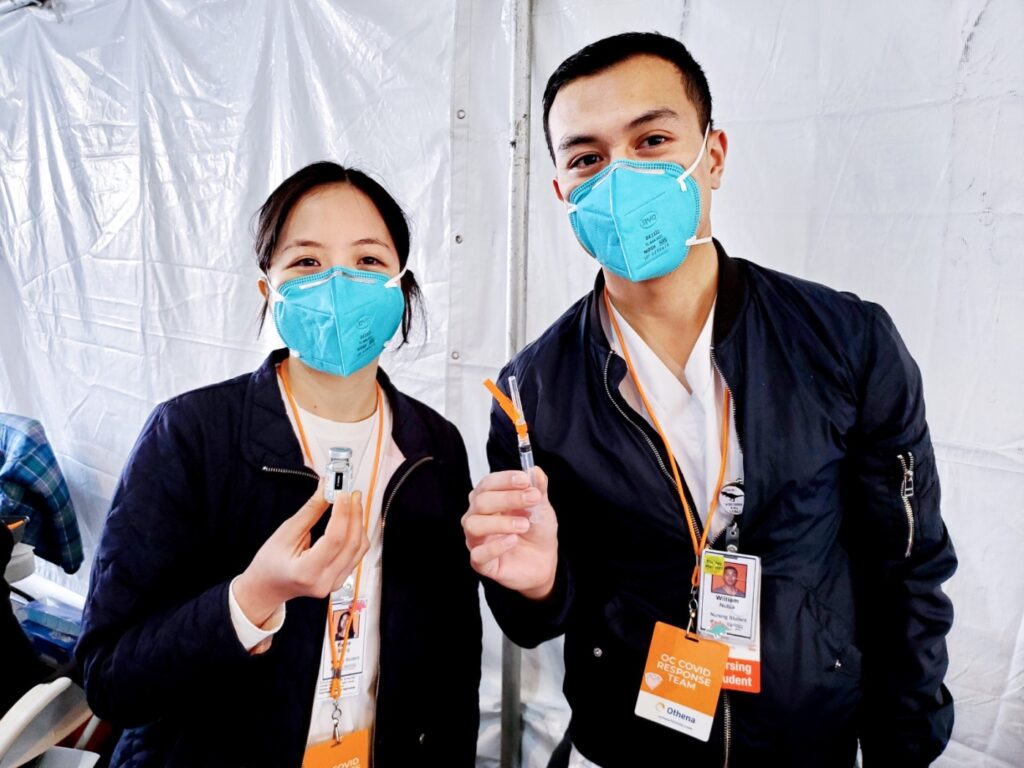
By Nicole Gregory, contributing writer
When the COVID-19 pandemic exposed disparities in health among different populations in Southern California, advocacy groups and politicians insisted that gaps in care must be closed. Nursing is critical in addressing these gaps, according to “The Future of Nursing 2020–2030,” a report from the National Academy of Sciences, Engineering and Medicine.
“Nurses live and work at the intersection of health, education, and communities,” according to the report. It went on to say that nurses must be trained and prepared to meet the needs of a diverse population.
This is precisely the mission of Cal State Fullerton’s nursing program.
“COVID shined a light on what some of us already knew in terms of health disparities,” said Hannah Fraley, assistant professor in the School of Nursing at CSUF. “Marginalized groups are demanding change and the health care workforce is being held accountable.”
The Cal State Fullerton nursing program has received several grants to make this happen. Nurses are being prepared “to work competently and justly with different populations and patients with marginalized status,” Fraley said. The school is also recruiting and retaining nursing students who are diverse, so they better match the population they are being trained to work with, she said. Administrators are recruiting and retaining a diverse nursing faculty to match the students and the population of patients that surround Cal State Fullerton.
“Our effort is not to have a checkbox approach,” Fraley said. “Like OK, check, we did diversity there.” Instead, she said, diversity, equity and inclusion “are being infused across our programs and courses and how we conduct our operations as a faculty.”
For years, nurses tended to be older white women, she explained. “We recognize that we need to close the gaps among our nursing faculty and the need for a diverse and equitable approach in how we teach and treat students in our classes.”
The pandemic has not deterred students from applying to the CSUF nursing program — in fact, the school recently received 2,000 applicants for 40 spots. According to the American Association of Colleges of Nursing, student enrollment across the country for entry-level baccalaureate nursing programs increased by more than 3% in 2021.
Cal State Fullerton nursing students are sent to work in a variety of community settings. “We have such an innovative program—students go to four counties: Orange, Los Angeles, San Bernardino, and Riverside,” said Maria Matza, the RN-BSN Pathway coordinator and associate professor. “They work at school sites, afterschool programs for high-risk youth, low-income communities for seniors, several Boys and Girls Clubs, community food banks and family shelters.”
Nursing students also work with families at the CSUF Center for Healthy Neighborhoods — a partnership program between the city of Fullerton and the university. During the pandemic, these student nurses continued to provide health education — including mental health — virtually, in Spanish and English, using Zoom, and accessed by community residents using What’s App on their cellphones.
Students assist at the Illumination Foundation, providing health education and emotional support to people experiencing housing insecurity who’ve been discharged from the hospital and need recuperative care, Matza explained. Student nurses also work in multiple childcare and after-school programs through La Habra Child Development Programs, she said.
“During the pandemic, our student nurses taking pediatrics completed their clinical hours at the La Habra Community Center with the 12-hour childcare program and virtual school for children of essential workers.”
Another way the nursing program prepares students for community work is the bi-annual poverty simulation exercise, coordinated by Matza, in which students are placed in simulated situations of families struggling with limited finances to keep a roof over their heads, feed their children, get to work or find work while trying to keep the family together.
This exercise is designed to help students become aware of their own biases toward those caught in the cycle of poverty. It also helps them understand the energy required to navigate community and social institutions, such as education, social services and finances.
To ensure these efforts are truly addressing the needs of all Southern California communities, grant funding is being used to build an advisory board made up of community stakeholders.
“The community advisory board will look into our programs for recruiting and retaining students and faculty and give us their input on how we can better serve vulnerable patients and minority patients in the community,” Fraley said.
“They will look at the program with the diversity, equity, and inclusion lens. I am very glad to have this board that will provide that critical feedback to us,” she said. “Did we forget a vulnerable population right in our community? That’s going to be really exciting to build that community partnership model.”
Related Articles
CSUF student, professor join forces to eliminate negative language in university policy
CSUF’s Spring Economic Forecast delivers mixed news for county
Experience CSUF event gives future students a glimpse of college life
CSUF alum pays it forward through philanthropy, mentorship
Russia must account for its war crimes, experts say
